WARNING!
The use of this additive in the motor fuel E85 may result in a poor engine function due to sediments and clogging of the fuel system.
The use of this additive in the motor fuel E85 may result in a poor engine function due to sediments and clogging of the fuel system.
To manufacturing ωFe requires a little chemistry expertise. The problem is that one must first produce olive oil soap, but when that is done does it only take a few moments before ωFe is available. ωFe is economical and can be produced without high consumption of expensive chemicals. These are: olive oil, sodium hydroxide (caustic soda), methylated spirits and copperas (iron sulfate).
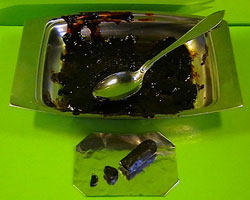 On the picture one can see a recent somewhat oily ωFe (iron oleate) and the solid/dry variant.
On the picture one can see a recent somewhat oily ωFe (iron oleate) and the solid/dry variant.
I have chosen to call this omega-Fe or an omega-additive because it is derived from oleic acid - a carboxylic acid. Oleic acid is a vegetable unsaturated fatty acid which can be found in olive oil. This acid is extremely useful as it also is known as omega-3 or omega-6. The fatty acid in olive oil is, however omega-9. Vegetable products containing omega-3 include rapeseed oil and avocado fruit. ωFe correct name is iron oleate, which then is the iron salt of oleic acid. ωFe and its molecule is small enough to dissolve in both naphtha's, light hydrocarbons and secondary alcohols.
The consistent of ωFe looks like dough that consists of resin. That dough can be baked to tablets of various forms (which, however directly adheres to a fuel-coated surface). I have chosen to waive a tablet version because it can take a very long time before it dissolves into a fuel and has it an unfortunate form could it block the supply of fuel. However, it is no problem at all to incorporate ωFe in one of my additives. ωFe is soluble in D66, T66, A40 and ISO. Since D66 also is used in combination with the glycol additives, covering ωFe up everything (in a clever way).
Performance
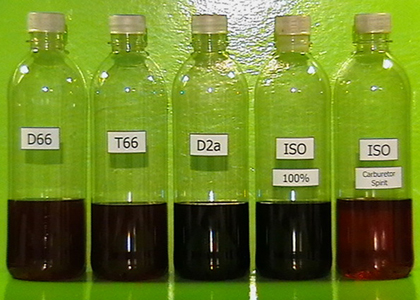 Fuel additives on a row prepared with ωFe (D2a is nowadays named A40). Some color variation can be distinguished.
Fuel additives on a row prepared with ωFe (D2a is nowadays named A40). Some color variation can be distinguished.
ω-additive:
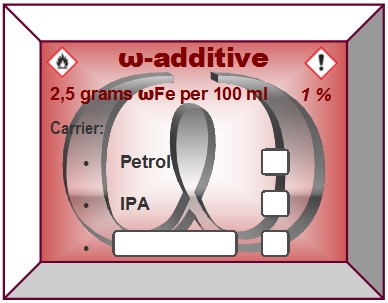
The base is thus a fuel additive and which is prepared by this iron salt. A ω-additive becomes quite dark and no special marking more than the label above exist - the color reveals what it's like.
ωFe also works together with glycol additives but not with the red glycol or G+. As with MCO20 is also ωFe flock prone with red glycol! The flocking tendencies for ωFe are hard to trigger but with red glycol occurs flocculation although it may take time. ωFe together with blue glycol (not Biltema) works well. Since ωFe should not be used in fuels where the ethanol content is high - falls the dilemma to board ωFe with glycol automatically.
A ω-additive can be created with for example D66 and/or A40. ISO can keep ωFe but is not recommended, since IPA can ruin the effect of other additives.
Diesel, white spirits, lighter fluid, gasoline, IPA - are good solvents for ωFe, while acetone and some C-spirits are not so good. Virtually all petroleum products are good solvents for ωFe. E85 solve ωFe relatively good because E85 contains gasoline. Ethanol (denatured alcohol) and methanol are poor solvents, while glycol and water not can dissolve ωFe.
 |
|||
For petrol (gasoline). |
|||
Dose factor: 0.01 |
1 % |
||
Identical with |
|||
2 parts acetone 3 parts D66 5 parts petrol (V-Power or alkylate) ωFe (soluble and separate) sum = 10 parts |
1 part A40 1 part petrol sum = 2 parts |
||
Commentary |
|||
The disadvantage with A40 is that the additive emits omega-Fe, if it must stand still for a while. By using a (high octane) petrol component will omega-Fe
better be solved in the liquid. |
|||
Consumption gain: 2-5 % |
|||
The content of ωFe: 300 ppm |
Opening time reduction: -10 % |
||
The result after a several tests conducted with ”FeTA-fuels”
2015 and 2016 tests were carried out with both ωFe and ferrocene in symbiotically with dEC. The test figures showed a fuel consumption reduction of around 10%. Later controls (2017) are against such a saving effect and all points instead of a plus-minus zero result. If the reason is due to a malfunction that I have made or that the commercial petrol was upgraded in 2017, I unfortunately can not inform anyone, but it still seems possible to get an improvement in the power output using FeTA.
2015 and 2016 tests were carried out with both ωFe and ferrocene in symbiotically with dEC. The test figures showed a fuel consumption reduction of around 10%. Later controls (2017) are against such a saving effect and all points instead of a plus-minus zero result. If the reason is due to a malfunction that I have made or that the commercial petrol was upgraded in 2017, I unfortunately can not inform anyone, but it still seems possible to get an improvement in the power output using FeTA.
Preparation step by step
If you not can buy soap based on olive oil, then you must make it by your own - this is easy. The method is based on the production of ”hot stirred soap”, but in this context are we not beyond ”cold stirred” which means that the washing procedure can be abolished. The result is an incomplete crude stirred soap that is highly alkaline and unsuitable for anything - except to make ωFe with. In fact; up to this point occurs rarely any complications but is one intend to produce hand-friendly soap, so it will be a number of stages beyond my instructions and then can it be messy.
If one is more interested in hand soap is it described at the bottom of this page, plus a couple of sidings that also are interesting. It is easy to fall into sidings one not planned, while one are in the process to develop something.
A batch thus consists of 100 ml of olive oil provides about 150 ml of crude stirred soap, which is enough to at least 3000 ml of an ω-additive.
Manufacturing of caustic soda (lye)
First, one should complete the lye - that simplifies the processing. Caustic soda is sodium hydroxide solution (white powder - the same as caustic soda) and water! A typical ”soap simmer lye” is 30%. Thus, 30 grams of sodium hydroxide to 70 grams of water - this is called a 10.7 molar solution, which is highly corrosive - use dishwashing gloves and eye protection! 10.7 M is equivalent of 429 grams hydroxide per litre of water. The hydroxide is added slowly with constant stirring in cold water. The caustic liquor becomes then very hot and unpleasant during the hydroxide dissolves. After the reaction subsided and the liquor has cooled has the volume changed insignificantly. If one used 70 ml of water is the volume of the lye around 72-73 ml - afterwards.
The problem is that current drain cleaners not only are hydroxide but also various water-insoluble substances, salt and binders. Shall only one batch be produced (100 ml olive oil) can 23 grams hydroxide be stirred into 50 ml of water. Sometimes consists this of lye plus amounts of insoluble substances floating in the liquor. On the bottom of the container may it be a salt that not can be solved - this is common table salt. The sodium hydroxide pushes away the saline - it must go away. It is easy to sever when the lye is poured in a filter (a coarse mesh like a reusable coffee filter or strainer) into another container. This kind of strong caustic soda is difficult to filter so one has to use a filter that is reasonably well adapted for the purpose. Remember not to use aluminum utensils or coffee filters of paper. If salt is precipitated should it be replace with new hydroxide.
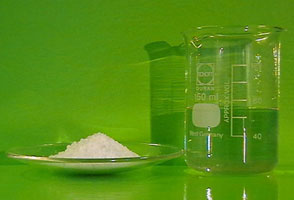 Sodium hydroxide and water
Sodium hydroxide and water
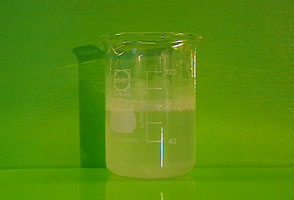 becomes lye
becomes lye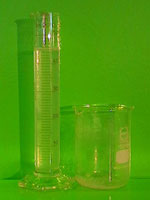 Filtered lye into a measuring cylinder. Note the indwelling saline in the bottom of the beaker.
Filtered lye into a measuring cylinder. Note the indwelling saline in the bottom of the beaker.
Manufacturing of crude stirred olive oil soap
The ingredients for a batch:
- 100 ml olive oil
- 45 ml lye 30%
- 35 ml methylated spirits (concentrated ethanol)
Add the lye and the alcohol together with the olive oil and stir constantly with a spoon. To supply heat here will not accelerate the soap formation process! After a minute or two is the soap formed - the green-red liquid thickens and becomes leathery. Eventually is one trying to as best one can to mess around a messy but fairly homogeneous dough-like mass. Continue to knead and massage the dough. This is thus the crude stirred olive oil soap and can be stored in any container (not aluminum). The soap is alkaline, which it must be when the sodium oleate shall be translated into iron oleate, which is the next step. Over the years has the technology for the production of olive oil soap been refined and from what I've seen: none unreacted oil will be created. This product can therefore be considered as 100 percent saponified. A picture below shows a coffee filter containing unreacted ”vegetable oil”. This may be true, but for the most part will this soap product be solved up completely in the 140 degree water, if it just remains in there long enough?
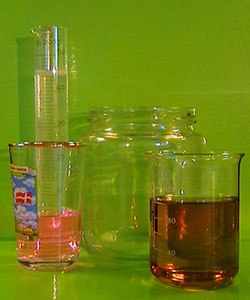 All ingredients (measured) that shall become soap, based on 100 ml olive oil...
All ingredients (measured) that shall become soap, based on 100 ml olive oil...
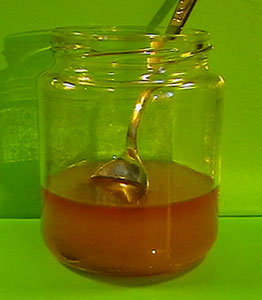 In the beginning it is flowing
In the beginning it is flowing
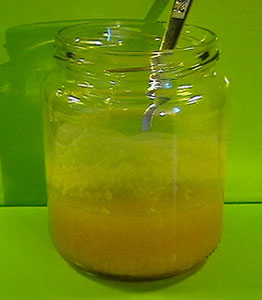 Shortly thereafter, viscous
Shortly thereafter, viscous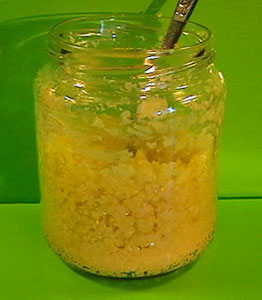 In order to at the end became the crude stirred olive oil soap.
In order to at the end became the crude stirred olive oil soap.
Manufacturing of ωFe
Then ωFe resembles of tar in its consistency, it makes sense if one do not have to transport it from one location to another. The solution to the problem is that the reaction that creates ωFe takes place in a closed container and that the pure fuel additive (gas, D66, A40 or ISO) is added in there. ωFe can then be dissolved in it and thus be recovered as a crude ω-additive.
To clarify the different steps will I here and now prepare 400 ml ω-additive in a Vitamin Well PET-bottle (which is a quite small batch). A container capable to board and heat 400 ml of water is required - for example a sauce pan? Take warm tap water so it gets hot faster. Now add the crude stirred olive oil soap after this formula:
Weight olive oil soap (grams) = Amount water (ml) x 0.033
The factor of 0.033 applies for additives dosed with 1%! In autumn 2016 establish the final content of iron oleate and is now 300 ppm. 0.033 is the factor that gives the weight of soap from a variety of water / additive A20. 0.030 is the minimum that still provides good fuel economy, and more than 0.035 are unnecessary. The risk to start with 0.035 or more is that the engine may occasionally misfire. Thus: 0.033 for A20 and 0.07 for A40 (dosed with 0.5%). Experiments have shown that it is possible to dissolve oleate of twice the amount in A40, in addition is the layering process faster then. Layering take place in a few hours but the disadvantage is that A40 release omega-Fe with time, if it not is used. dEC-M3 has proved to work perfectly during tests carried out in 2016 and if one wants to use this additive one have to produce A40 with omega-Fe first. When producing omega-Fe for A40 is it important that the water that is used not are reduced. Proceed as if it was about a 1% additive, ie start with 0.033 but when the fuel additive at last is incorporated - count with 0.07 (half of the water volume).
The weight of iron oleate from a certain weight of soap stays around 70 % - if the chemical reaction goes in the right direction... The weight of soap in this case is thus 13 grams (divided into 400 ml). This provides approximately 2 grams of iron oleate per 100 ml. Whatever type of fuel additive so will the content of oleate be close to 1 gram per gallon of gas.
Make sure to warm the water to about 140 degrees so that the soap dissolves. On top of the soap solution flows now insoluble clumps which means that it can take a long time before all soap is dissolved. If the soap refused to be solved without raising the temperature so one can assume that it is fatty lumps that have not been transformed into soap and it can then be filtered out. We now have a bottle filled with 400 ml of warm soapy water and that shall react with twice the weight of copperas - that is 26 grams. A turnover reaction starts! Sodium oleate turns to iron oleate and iron sulfate to sodium sulfate.
The solution pH during the reaction should be 7 (neutral)! If using old olive oil may it happen that no reaction occur between
the soap/sulfate, and it can be seen by that the sulfate just floating around in the soapy solution. The reason is that the solution is alkaline and you have to
add an acid. It is best to use sulfuric acid as one drops in it until the sulfate begin smudging and lump together. Battery acid is good enough but it works
with Oxalic acid also - mixed with water. A teaspoon of oxalic acid (5 ml) in 50 ml of water - about 20 ml of this per 1000 ml of solution is a good target
value but may vary from case to case. Probably is the best to immediately make soap of your newly purchased olive oil?
You can shake the bottle now and then and wait for about 15 minutes. Attempts have been made with a longer time but the exchange will be the same. The risk if one waits too long is that: the solution cools so that the melted fat (not omega-Fe) solidifies and remains in the container. For this reason, it may be smart to be a bit over 140 degrees maybe 150-160 degrees before sulfate-contact. However, make sure that the 15 minutes before the waiting washing-phase begins, not exceeded! The water contains only dissolved contaminants and must be separated from the solid content, which is iron oleat / ωFe. This tar-like smelly mass is prone to partially stick onto the bottle walls but before the washing process is complete flows it above the water solution.
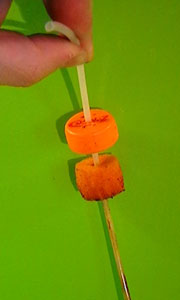
Washing is best done by first prepares a cork with small holes. This cork is fitted with a piece of foam that acts as a filter. If one inserts a narrow hose through the foam rubber so will it hold the rubber in place. Now one can empty the bottle from water without that any iron oleat comes with it. Fill the bottle again with clear water and shake - drain the bottle (blow in the hose) and repeat two more times. The last two rinses are done with a little alcohol (ethanol). Shake and drain out - repeat once more. Attempts to knead and massaging the residual ω-pulp with an oblong metallic object (a pin, long screwdriver) in conjunction with alcohol, to remove all water. Now is the interior of the bottle free from almost all water and one can pour in the additive which one intend to solve ωFe in.
Although the moisture is replaced by alcohol it is difficult to remove all water. Water in a ωFe-addition is hazardous and can cause decomposition and flocculation! The bottle now contains approximately 10 grams of iron oleate or ωFe. Now, fill the bottle with 400 ml of any naphtha additive and let the iron oleate dissolve itself - this may take several hours. The result is 400 ml crude ω-additive and the color is now almost black. The last remaining step is to separating the solid particles.
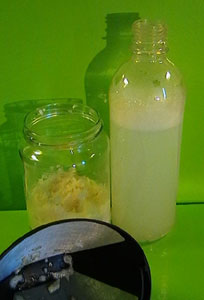 Filtered soap solution
Filtered soap solution
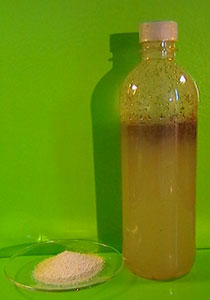 After addition of copperas
After addition of copperas
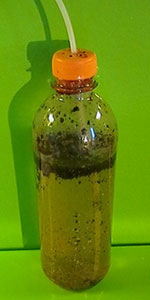 Washing
Washing
When copperas was added formed also ferric hydroxide due to the prevailing hydroxide excess. Ferric hydroxide is the first stage of rust and can be burned, as well as iron oleate into oxides. Ferric hydroxide is not solvent-prone at all and should be removed sooner or later. The particles are unfortunately very small and can not be stopped by a fuel filter that easy. If one wait long enough will the ferric hydroxide sink to the bottom of the current bin but it may take several days until the separation is finished. To optimize the elimination of ferric hydroxide may one first let the ω-additive stand for one day in a high and transparent bottle - then gently pour the addition into an another empty bottle. A bright light that shines in the bottle makes that one can see when the veils of particles is on the way out, but then have one probably separated perhaps up to 80-90%. The separation process is then repeated a second time and then one should probably wait at least two or three days - if one is in a hurry one can use a HEPA filter. If one waits a whole week become the solution completely clean.
To facilitate the manufacture of ω-additives is a manual here.
To manufacture ωFe and later a ω-additive comprises some more steps and moments than eg producing of MCO20. One can pretend that it is an exercise in what it means to be a chemist? Personally I think that this is a relatively simple operation and the number of stage does not bother me. The main drawback is the handling of petroleum products that is not really particularly healthy. One should think of the ventilation and wear gloves whenever possible.
Copper oleate
Instead for iron sulphate, one can test copper oleate. The result is a greenish mass whose characteristics are very similar to iron oleate. One application for copper oleate is to serve as a component in fuel additives, but I prefer iron oleate that's actually seems to be a straw sharper than a copper ditto. The substance is manageable ie easy to work with, unlike iron oleate that feels very sticky in comparison.
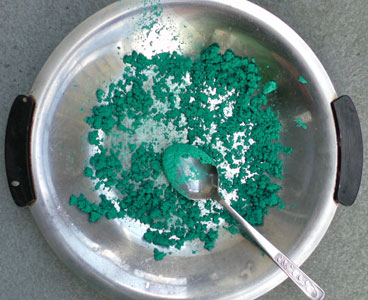 Dry copper oleate ready for some additive.
Dry copper oleate ready for some additive.
In solution terms, one can consider copper oleate as if it was iron oleate or vice versa - no difference there. The major drawback is that all copper salts are many times more expensive than for example iron salts, so that is a troublesome aspect. NOTE. The dosage of copper sulphate in the crude stirred soap solution should be as large as the freely crude stirred soap was - in quantity/weight respect, not double as is the case with iron sulphate. Regarding the washing process: only one bottle is also okay here. So instead of transferring the oleate to a platter one can make the final wash with ethanol (methylated spirits) in the same bottle as it was formed in, but it does not prevent you to let it evaporate on a platter either... There is an interesting connection with hexamethylenetetramine (HMTA or hexamine) here. The most suitable oxidant for hexamine is namely copper oxide. Therefore it would be interesting to try to combine a copper compound with hexamine. However, I have not noticed something extraordinary with copper oleate and hexamine. Maybe someone else can figure out how it should be arranged?
Hand soap and other sidings
The step is not far from producing its own soap if we have come that far that we have crude stirred soap according to the method described above.
When the crude stirred soap is ready can it get sit for an hour - to be absolutely sure that the reaction has subsided. When it's time shall boiling water be added and common salt (sodium chloride) also. For 100 ml of olive oil shall 270 ml of water be measured, which implies that nothing has been used to produce ωFe? The weight salt is 23 grams to 70 ml of water and should be prepared in a special container (salt should be dissolved in water before it is turned into the soap bath). While the hot water is added can one begin the heating too. The water should be added slowly while stirring. When the water is added, so one can pour the saline solution. This will now boil a few minutes - and that's it!
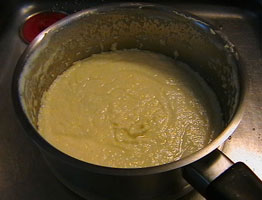 Boiled soap, here during the cooling
Boiled soap, here during the cooling
 Filtered mass of soap
Filtered mass of soap
The point of these procedures is that the alkaline hydroxide is collected in the water rather than in the soap. The soap will now also include salt and an insignificant amount of hydroxide. The salt has preservative action and keeps the soap fresh. Without preservative will soap become rancid.
Let this soap/water be cooled (put the pan in cold water). Then pour the whole thing in a coarse filter or in a coffee filter. Most of the water will now depart, leaving just the soap - but it's still a bit humid though. This soap mass can now fill a form with an ordinary solid soap to be produced? If you make this will the soap shrink considerably during the time it dries - it depends on the high water content. One way to get rid of the water is to centrifuge the soap mass. It may, for example making a sling - a cord which is attached to such a coffee filter can be rotated with only manual power. So in that way will one avoid too much shrinkage.
A mold that is made of a mackerel or herring jar works perfectly. Be careful to avoid the formation of voids/air pockets in the mold! The soap must now lie still at least for a day before one can shake it (gently) out from the mold. Over the time harden the soap and it shrinks slightly. Place the soap near a heat source and the drying process goes faster. After several weeks is the soap finished and is then completely white.
 A finished soap and the mold.
A finished soap and the mold.
Liquid soap should be made as soon as it is new and centrifuged. There is water to be mixed with soap mass but this should be done after a certain methodology. If you have received a relatively porous soap mass which is centrifuged and quite loose, so can the weight of mass corresponds to the weight of water (50/50). As for an example shall 100 grams soap mass be blended with 100 ml water. It is best to add the first 1/3 of the water in the soap and then heating it to boiling - then allowing it to cool. This is repeated once more, but the final third portion of water is added directly into the soap without any heating. The result is smooth and homogeneous liquid olive oil soap.
Green soft soap
Is made from tall oil which is reacted with potassium hydroxide - the potassium variant of caustic soda. It is the so-called black lye that is derived from paper mills that the green soft soap originally comes from. The difference of a soap which has been treated by a fat or oil and with either potassium or sodium-based lye - is the consistency. Solid soap such hand-soaps are based on sodium while liquid soap or soft soap are based on potassium.
When the base component of green soft soap is an potassium-ester of tall oil (potassium resinate), it's pretty easy to let it react with copperas. The result is iron resinate and potassium sulfate. The sulphate is water soluble and can therefore easily be separated from the iron resinate. Iron resinate is like iron oleate tar-like and reminiscent of tar or wood tar, but with a reddish tinge. Like iron oleate are also iron resinate soluble in naphtha. The disadvantage of iron resinate is that it is flocculation prone. If one mix it with naphtha will it looks good at the beginning, but after a day or two has it usually formed flocks and the naphtha has become cloudy.
Ointment or cream of salts from oleic acid
Resinates and oleates are not compounds that are harmful. They are actually used as ointments for various skin conditions. Exactly how to make such an ointment or cream I do not know but if one wants to try to use such iron oleate as an ointment, one should reduce the dose of copperas. Add the same amount of copperas as soap - this will give a more greasy texture of iron oleate, which is easier to use as an ointment.
Poor man's HAMLET is actually called BAMLET
No I'm not kidding, HAMLET as I have written about in ”the news bulletin”, which is a highly effective anti-cancer drug and that it cures at least 40 different cancers - only consisting of breast milk mixed with oleic acid. So it is a completely a non-toxic drug that are easy and inexpensive to manufacture. One might ask what other good qualities such oleic acids have? This is thus about oleic acid and protein. When oleic acid and olive oil in principle is the same thing, seemed its raw materials are widely available.
Olive oil, rapeseed oil and linseed oil are in varying degrees carriers of these oleic acids and these are; omega-3, omega-6 and omega-9. For those of you who do not have access to breast milk, is the option BAMLET available - it resembles of HAMLET but then with regular cow's milk. According to google will also BAMLET have exhibited similar characteristics as its predecessor. BAMLET is thus an effective cancer killer as HAMLET is - if some efforts are made one can conclude that it is so.
So, how are we now proceed to get this mega medicine? One can assume that such a mix of oil and milk at least bring an extremely good health to oneself and even if one do not have cancer, so it should be preventive and also prevention in a broader perspective? The answer is simple: Mix a protein drink with olive oil! The method I can recommend is to move down one part olive oil in 20 parts of cultured milk. Then filter the mixture through a coffee filter. The filtrate is now a transparent fluid and cultured milk-tasted liquid that hopefully will correspond to a cure of BAMLET.
|
| |
|
| |




